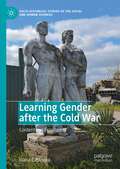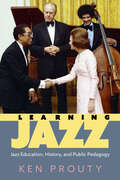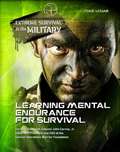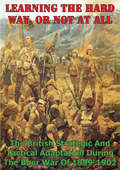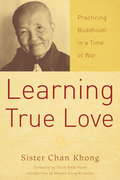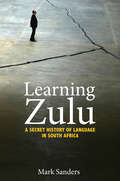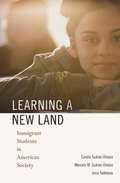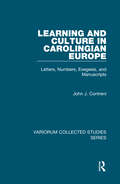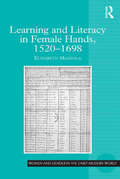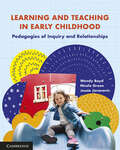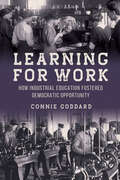- Table View
- List View
Learning Gender after the Cold War: Contentious Feminisms (Socio-Historical Studies of the Social and Human Sciences)
by Ioana CîrstoceaThis book explores the role and place of feminist politics in the transformation of the former socialist world and points out the geopolitical mechanisms involved in the deployment of technocratic norms, expert discourses, activist repertoires and academic knowledge on women’s rights and gender equality in the 1990s-2000s. Based on an interdisciplinary approach and scrutinizing transnational flows of people, resources and ideas, the analysis brings together themes and spaces that have been disconnected in previous scholarship. It sheds light on the integration of feminist resources into contemporary governance through complex entanglements of international aid to democratization, “activism beyond borders” and systemic transformation of higher education.The book will be of interest to researchers and students of sociology, political science, gender studies, and East-European studies.
Learning Jazz: Jazz Education, History, and Public Pedagogy (American Made Music Series)
by Ken ProutyLearning Jazz: Jazz Education, History, and Public Pedagogy addresses a debate that has consumed practitioners and advocates since the music's early days. Studies on jazz learning typically focus on one of two methods: institutional education or the kinds of informal mentoring relationships long associated with the tradition. Ken Prouty argues that this distinction works against a common identity for audiences and communities. Rather, what happens within the institution impacts—and is impacted by—events and practices outside institutional contexts.While formal institutions are well-defined in educational and civic contexts, informal institutions have profoundly influenced the development of jazz and its discourses. Drawing on historical case studies, Prouty details significant moments in jazz history. He examines the ways that early method books capitalized on a new commercial market, commandeering public expertise about the music. Chapters also discuss critic Paul Eduard Miller and his attempts to develop a jazz canon, as well as the disconnect between the spotlighted “great men” and the everyday realities of artists. Tackling race in jazz education, Prouty explores the intersections between identity and assessment; bandleaders Stan Kenton and Maynard Ferguson; public school segregation; Jazz at Lincoln Center; and more. He further examines jazz’s “public pedagogy,” and the sometimes-difficult relationships between “jazz people” and the general public. Ultimately, Learning Jazz posits that there is room for both institutional and noninstitutional forces in the educational realm of jazz.
Learning Large Lessons
by David E. JohnsonThe relative roles of U.S. ground and air power have shifted since the end of the Cold War. At the level of major operations and campaigns, the Air Force has proved capable of and committed to performing deep strike operations, which the Army long had believed the Air Force could not reliably accomplish. If air power can largely supplant Army systems in deep operations, the implications for both joint doctrine and service capabilities would be significant. To assess the shift of these roles, the author of this report analyzed post?-Cold War conflicts in Iraq (1991), Bosnia (1995), Kosovo (1999), Afghanistan (2001), and Iraq (2003). Because joint doctrine frequently reflects a consensus view rather than a truly integrated joint perspective, the author recommends that joint doctrine-and the processes by which it is derived and promulgated-be overhauled. The author also recommends reform for the services beyond major operations and campaigns to ensure that the United States attains its strategic objectives. This revised edition includes updates and an index.
Learning Legacies: Archive to Action through Women's Cross-Cultural Teaching
by Sarah Ruffing RobbinsLearning Legacies explores the history of cross-cultural teaching approaches, to highlight how women writer-educators used stories about their collaborations to promote community-building. Robbins demonstrates how educators used stories that resisted dominant conventions and expectations about learners to navigate cultural differences. Using case studies of educational initiatives on behalf of African American women, Native American children, and the urban poor, Learning Legacies promotes the importance of knowledge grounded in the histories and cultures of the many racial and ethnic groups that have always comprised America’s populace, underscoring the value of rich cultural knowledge in pedagogy by illustrating how creative teachers still draw on these learning legacies today.
Learning Mental Endurance for Survival
by Chris McnabElite Special Forces units are often assigned to the most difficult missions. They must be prepared for the challenges they will face. This means being skilled and physically fit, but it also means being mentally tough. During most basic-training programs, recruits will be yelled at by instructors, deprived of sleep, and forced to run for miles. Under these difficult conditions, they will be required to make constant decisions. Only the toughest recruits will graduate, and they need certain traits to make it through: * intelligence * self-control * courage * knowledge * resistance to pain and discomfort * team spirit
Learning One’s Native Tongue: Citizenship, Contestation, and Conflict in America
by Tracy B. StrongCitizenship is much more than the right to vote. It is a collection of political capacities constantly up for debate. From Socrates to contemporary American politics, the question of what it means to be an authentic citizen is an inherently political one. With Learning One’s Native Tongue, Tracy B. Strong explores the development of the concept of American citizenship and what it means to belong to this country, starting with the Puritans in the seventeenth century and continuing to the present day. He examines the conflicts over the meaning of citizenship in the writings and speeches of prominent thinkers and leaders ranging from John Winthrop and Roger Williams to Thomas Jefferson, Nathaniel Hawthorne, Abraham Lincoln, Frederick Douglass, and Franklin Roosevelt, among many others who have participated in these important cultural and political debates. The criteria that define what being a citizen entails change over time and in response to historical developments, and they are thus also often the source of controversy and conflict, as with voting rights for women and African Americans. Strong looks closely at these conflicts and the ensuing changes in the conception of citizenship, paying attention to what difference each change makes and what each particular conception entails socially and politically.
Learning Policy: When State Education Reform Works
by David K. Cohen Heather C. HillThis book reports on one of the more significant school-improvement policies in late-twentieth-century America: California's decade-long effort to change and improve mathematics teaching in the state's public schools.
Learning The Hard Way, Or Not At All: The British Strategic And Tactical Adaptation During The Boer War Of 1899-1902
by Major Rob B. McClaryThe United States' current strategic environment is increasingly complex, with security, economic, and humanitarian interests around the world. Consequently, the United States' military may be called upon at any time to perform missions ranging from peacekeeping to total war, in environments ranging from the desserts of South West Asia to the jungles of Central America, against enemies ranging from Somali warlords to Chinese divisions. This uncertainty prevents the United States' military from organizing, equipping, and training for any specific situation. Therefore, to be successful the United States military must be capable of quickly adapting to the particulars of its mission when called.In the late 1800's England found itself in much the same position, with its military engaged around the world protecting its diverse and widely-dispersed interests. In 1899 when it went to war against the Boers it found its military unsuited for the South African terrain, the effects of modern weaponry, and the unconventional Boer tactics. This paper examines the British military's strategy and tactics, and how they changed throughout the war. Ultimately it determines that the British failed to adapt their strategy and tactics effectively throughout the war. Although their performance varied from commander to commander, and from unit to unit, the British typically resisted change, for various reasons, even when the need for change was pressing.
Learning Theology with the Church Fathers
by Christopher A. HallLearning Theology with the Church FathersReading Scripture with the Church Fathers,
Learning Theory and Behaviour Modification (Routledge Library Editions: Psychology of Education #47)
by Stephen WalkerThe ability to learn is of crucial importance in human life, but understanding this ability has proved to be difficult. There have been many attempts to formulate scientific theories based on both animal experiments and human experience; and these have been applied to education and the treatment of psychological disturbance, with a certain amount of success. Originally published in 1984, this incisive guide to the research and its outcomes provides the background to one of the most debated topics in psychology today. Learning Theory and Behaviour Modification introduces the work of major figures, such as Pavlov and Skinner, which has strongly influenced theories in educational and clinical psychology, and formed the basis of the techniques known as ‘behaviour modification’. As well as giving examples of these techniques the author relates new ideas about the scope and limits of behaviour modification to recent changes in the views of learning theorists. How much can experiments on animals tell us about human psychology?
Learning True Love: Practicing Buddhism in a Time of War
by Sister Chan KhongLearning True Love, the autobiography of Sister Chân Không, stands alongside the great spiritual autobiographies of our century. It tells the story of her spiritual and personal odyssey, both in her homeland and in exile. <P> Its anecdotal style presents an intensely personal portrait of a woman with astonishing courage, offering us a perspective on the suffering of the Vietnamese people. This unique autobiography tells the gripping story of a woman who not only lived but made history, and whose life of single-minded dedication to humanity can serve as an inspiration for us all.Sister Chân Không was born in a village on the Mekong River Delta in 1938. In her teens she devoted her life to the development and practice of nonviolence grounded in the Buddhist precepts of non-killing and compassionate action. Propelled by her passionate dedication to social change, she began working in the slums of Saigon, distributing food, working with the sick, and teaching children. When she was 21 years old she met the man who until to this day remains her teacher and spiritual companion: Thich Nhat Hanh. With him she co-founded the School of Youth for Social Service in 1964, which grew to an organization of over 10,000 young people organizing medical, educational, and agricultural facilities in rural Vietnam, and rebuilding villages destroyed in the fighting. Sister Chân Không became well known in the anti-war and peace community for her work promoting human rights and protesting repression and violence, often at risk of her own life. She continues to do this work today. After the war she became one of the co-founders of Plum Village, the spiritual center, that is home to Thich Nhat Hanh's community in France, where she continues to be deeply involved in the development and vision for this unique community.In January of 2005, after nearly 40 years in exile, Sister Chân Không was able to return on a 3-month visit to Vietnam. In this fully revised edition of Learning True Love she movingly describes the return to her homeland, the reunions with many old friends and fellow activists, and shares her impression of the "new Vietnam," where Buddhists still struggle for religious freedom and the re-establishment of their own organizations. Learning True Love is a moving personal memoir, an introduction to the mindfulness teachings and life of Thich Nhat Hanh and his community in exile, an overview to the development of the European and American peace and human rights movement, and an introduction to the engaged and practical style of Vietnamese Buddhism. It documents the process that brought an end to the US Vietnam war, and gives a lively summary of Vietnamese history from 1945 to the current political, social and spiritual climate in Vietnam. Learning True Love also portraits some of the many remarkable people that shared Sister Chân Không 's path.Foremost however it is the remarkable and impressive story of a very courageous woman, whose journey from an accredited biologist at the University of Paris to a Buddhist nun, gives her unique insight into life's central questions and the ability to address them in an unflinching and straightforward manner. Forewords by Thich Nhat Hanh and Maxine Hong-Kingston
Learning Web Component Development
by Sandeep Kumar PatelThis book is the perfect reference for any web developer looking for an introduction to the new tools and techniques used to create web components.
Learning Zulu: A Secret History of Language in South Africa
by Mark Sanders"Why are you learning Zulu?" When Mark Sanders began studying the language, he was often asked this question. In Learning Zulu, Sanders places his own endeavors within a wider context to uncover how, in the past 150 years of South African history, Zulu became a battleground for issues of property, possession, and deprivation. Sanders combines elements of analysis and memoir to explore a complex cultural history.Perceiving that colonial learners of Zulu saw themselves as repairing harm done to Africans by Europeans, Sanders reveals deeper motives at work in the development of Zulu-language learning--from the emergence of the pidgin Fanagalo among missionaries and traders in the nineteenth century to widespread efforts, in the twentieth and twenty-first centuries, to teach a correct form of Zulu. Sanders looks at the white appropriation of Zulu language, music, and dance in South African culture, and at the association of Zulu with a martial masculinity. In exploring how Zulu has come to represent what is most properly and powerfully African, Sanders examines differences in English- and Zulu-language press coverage of an important trial, as well as the role of linguistic purism in xenophobic violence in South Africa. Through one person's efforts to learn the Zulu language, Learning Zulu explores how a language's history and politics influence all individuals in a multilingual society.
Learning a New Land: Immigrant Students in American Society, First Edition
by Marcelo M. Suarez-Orozco Carola Suarez-Orozco Irina TodorovaBased on an extraordinary interdisciplinary study that followed 400 newly arrived children from the Caribbean, China, Central America, and Mexico for five years, this book provides a compelling account of the lives, dreams, and frustrations of these youngest immigrants. Richly told portraits of high and low achievers are packed with unexpected ironies. When they arrive, most children are full of optimism and a respect for education. But poor neighborhoods and dull--often dangerous--schools can corrode hopes. The vast majority learn English--but it is the English of video games and the neighborhood, not that of standardized tests.
Learning and Culture in Carolingian Europe: Letters, Numbers, Exegesis, and Manuscripts (Variorum Collected Studies)
by John J. ContreniNine of the ten essays in this collection appeared first between 1995 and 2005. Centered in the Carolingian age, they explore how the seventh-century Visio Baronti was read in the ninth century and how social and cultural imperatives transformed the life of scholarship, schools and learning in Carolingian Europe. Several essays consider the significance of numerical and scientific studies in the Carolingian curriculum, including the impact of Bede's scientific works in the schools and on the thought of John Scottus (Eriugena). Another reconstructs Eriugena's early career in light of his Glossae divinae historiae. Carolingian biblical culture is the subject of two essays, including a reading of Haimo of Auxerre's commentary on Ezechiel that highlights the unfinished and unpublished commentary's critique of Carolingian society. A poem in the Anthologia Latina long ascribed to Octavian, the Roman emperor, is restored to the monastic culture of the ninth century. Finally, an article on the Laon Formulary, originally published in French in 1973, is here translated and revised.
Learning and Literacy in Female Hands, 1520-1698 (Women and Gender in the Early Modern World)
by Elizabeth MazzolaFocusing on the unusual learning and schooling of women in early modern England, this study explores how and why women wrote, the myriad forms their alphabets could assume, and the shape which vernacular literacy acquired in their hands. Elizabeth Mazzola argues that early modern women's writings often challenged the lessons of their male teachers, since they were designed to conceal rather than reveal women's learning and schooling. Employed by early modern women with great learning and much art, such difficult or ’resistant’ literacy organized households and administrative offices alike, and transformed the broader history of literacy in the West. Chapters treat writers like Jane Sharp, Anne Southwell, Jane Seager, Martha Moulsworth, Elizabeth Tudor, and Katherine Parr alongside images of women writers presented by Shakespeare and Sidney. Managing women's literacy also concerned early modern statesmen and secretaries, writing masters and grammarians, and Mazzola analyzes how both the emerging vernacular and a developing bureaucratic state were informed by these contests over women's hands.
Learning and Teaching in Early Childhood: Pedagogies of Inquiry and Relationships
by Nicole Green Wendy Boyd Jessie JovanovicLearning and Teaching in Early Childhood: Pedagogies of Inquiry and Relationships is an introduction for early childhood educators beginning their studies. Reflecting the fact that there is no single correct approach to the challenges of teaching, this book explores teaching through two lenses: teaching as inquiry and teaching as relating. The first part of the book focuses on inquiry, covering early childhood learning environments, learning theories, play pedagogies, approaches to teaching and learning, documentation and assessment, and the policy, curriculum and regulatory requirements in Australia. The second part explores relationships in early childhood contexts and covers topics such as fostering meaningful and respectful relationships with children, and working with families, staff and the wider community. Written by well-respected academics in the field, Learning and Teaching in Early Childhood is a vital resource for those entering the early childhood education and care profession.
Learning behind Bars: How IRA Prisoners Shaped the Peace Process in Ireland
by Deiter ReinischLearning behind Bars is an oral history of former Irish republican prisoners in the Republic of Ireland and Northern Ireland between 1971, the year internment was introduced, and 2000, when the high-security Long Kesh Detention Centre/HM Prison Maze closed. Dieter Reinisch outlines the role of politically motivated prisoners in ending armed conflicts as well as the personal and political development of these radical activists during their imprisonment. Based on extensive life-story interviews with Irish Republican Army (IRA) ex-prisoners, the book examines how political prisoners developed their intellectual positions through the interplay of political education and resistance. It sheds light on how prisoners used this experience to initiate the debates that eventually led to acceptance of the peace process in Northern Ireland. Politically relevant and instructive, Learning behind Bars illuminates the value of education, politics, and resistance in the harshest of social environments.
Learning for Work: How Industrial Education Fostered Democratic Opportunity
by Connie GoddardFounded in 1883, the Chicago Manual Training School (CMTS) was a short-lived but influential institution dedicated to teaching a balanced combination of practical and academic skills. Connie Goddard uses the CMTS as a door into America’s early era of industrial education and the transformative idea of “learning to do.” Rooting her account in John Dewey’s ideas, Goddard moves from early nineteenth century supporters of the union of learning and labor to the interconnected histories of CMTS, New Jersey’s Manual Training and Industrial School for Colored Youth, North Dakota’s Normal and Industrial School, and related programs elsewhere. Goddard analyzes the work of movement figures like abolitionist Theodore Weld, educators Calvin Woodward and Booker T. Washington, social critic W.E.B. Du Bois, Dewey himself, and his influential Chicago colleague Ella Flagg Young. The book contrasts ideas about manual training held by advocate Nicholas Murray Butler with those of opponent William Torrey Harris and considers overlooked connections between industrial education and the Arts and Crafts Movement. An absorbing merger of history and storytelling, Learning for Work looks at the people who shaped industrial education while offering a provocative vision of realizing its potential today.
Learning from Henri Nouwen and Vincent van Gogh: A Portrait of the Compassionate Life
by Carol A. BerryCarol Berry and her husband met and befriended Henri Nouwen when she sat in his course on compassion at Yale Divinity School in the 1970s. At the request of Henri Nouwen's literary estate, she has written this book, which includes unpublished material recorded from Nouwen's lectures. As an art educator, Berry is uniquely situated to develop Nouwen's work on Vincent van Gogh and to add her own research. She fills in background on the much misunderstood spiritual context of van Gogh's work, and reinterprets van Gogh's art (presented here in full color) in light of Nouwen's lectures. Berry also brings in her own experience in ministry, sharing how Nouwen and van Gogh, each in his own way, led her to the richness and beauty of the compassionate life.
Learning from Leonardo: Decoding the Notebooks of a Genius
by Fritjof CapraLeonardo da Vinci was a brilliant artist, scientist, engineer, mathematician, architect, inventor, writer, and even musician—the archetypal Renaissance man. But he was also, Fritjof Capra argues, a profoundly modern man. Not only did Leonardo invent the empirical scientific method over a century before Galileo and Francis Bacon, but Capra’s decade-long study of Leonardo’s fabled notebooks reveal him as a systems thinker centuries before the term was coined. He believed the key to truly understanding the world was in perceiving the connections between phenomena and the larger patterns formed by those relationships. This is precisely the kind of holistic approach the complex problems we face today demand. Capra describes seven defining characteristics of Leonardo da Vinci’s genius and includes a list of over forty discoveries Leonardo made that weren’t rediscovered until centuries later. Leonardo pioneered entire fields—fluid dynamics, theoretical botany, aerodynamics, embryology. Capra’s overview of Leonardo’s thought follows the organizational scheme Leonardo himself intended to use if he ever published his notebooks. So in a sense, this is Leonardo’s science as he himself would have presented it. Leonardo da Vinci saw the world as a dynamic, integrated whole, so he always applied concepts from one area to illuminate problems in another. For example, his studies of the movement of water informed his ideas about how landscapes are shaped, how sap rises in plants, how air moves over a bird’s wing, and how blood flows in the human body. His observations of nature enhanced his art, his drawings were integral to his scientific studies, and he brought art and science together in his extraordinarily beautiful and elegant mechanical and architectural designs. Obviously, we can’t all be geniuses on the scale of Leonardo da Vinci. But by exploring the mind of the preeminent Renaissance genius, we can gain profound insights into how best to address the challenges of the 21st century.
Learning from Madness: Brazilian Modernism and Global Contemporary Art
by Kaira M. CabañasThroughout the history of European modernism, philosophers and artists have been fascinated by madness. Something different happened in Brazil, however, with the “art of the insane” that flourished within the modernist movements there. From the 1920s to the 1960s, the direction and creation of art by the mentally ill was actively encouraged by prominent figures in both medicine and art criticism, which led to a much wider appreciation among the curators of major institutions of modern art in Brazil, where pieces are included in important exhibitions and collections. Kaira M. Cabañas shows that at the center of this advocacy stood such significant proponents as psychiatrists Osório César and Nise da Silveira, who championed treatments that included painting and drawing studios; and the art critic Mário Pedrosa, who penned Gestaltist theses on aesthetic response. Cabañas examines the lasting influence of this unique era of Brazilian modernism, and how the afterlife of this “outsider art” continues to raise important questions. How do we respect the experiences of the mad as their work is viewed through the lens of global art? Why is this art reappearing now that definitions of global contemporary art are being contested?Learning from Madness offers an invigorating series of case studies that track the parallels between psychiatric patients’ work in Western Europe and its reception by influential artists there, to an analogous but altogether distinct situation in Brazil.
Learning from Shenzhen: China’s Post-Mao Experiment from Special Zone to Model City
by Jonathan Bach Mary Ann O'Donnell Winnie WongThis multidisciplinary volume, the first of its kind, presents an account of China’s contemporary transformation via one of its most important yet overlooked cities: Shenzhen, located just north of Hong Kong. In recent decades, Shenzhen has transformed from an experimental site for economic reform into a dominant city at the crossroads of the global economy. The first of China’s special economic zones, Shenzhen is today a UNESCO City of Design and the hub of China’s emerging technology industries. Bringing China studies into dialogue with urban studies, the contributors explore how the post-Mao Chinese appropriation of capitalist logic led to a dramatic remodeling of the Chinese city and collective life in China today. These essays show how urban villages and informal institutions enabled social transformation through cases of public health, labor, architecture, gender, politics, education, and more. Offering scholars and general readers alike an unprecedented look at one of the world’s most dynamic metropolises, this collective history uses the urban case study to explore critical problems and possibilities relevant for modern-day China and beyond.
Learning from Somalia: The Lessons of Armed Humanitarian Intervention
by Walter S Clarke<p>The U.S.-led intervention in Somalia that began in December 1992 is the most significant instance to date of “peacemaking” by the international community. The heady promise of Operation Restore Hope and the subsequent disappointments have had a resounding impact on the policies of Western governments and the UN as they have tried to cope with humanitarian emergencies in Rwanda, Bosnia, and elsewhere. However, it is questionable how correct the lessons so quickly derived from the Somalia experience actually were. At the same time, many important organizational and operational innovations during the Somalia exercise have not received sufficient attention. Learning from Somalia is therefore critical if the international community is to respond better to tragedies that threaten millions of human lives. <p>Contributors to this book, many of whom are policymakers who were either in Mogadishu or Washington during the relief missions, examine the intervention in Somalia and draw lessons for future peacekeeping operations. They analyze many aspects of peacemaking that are not well understood, including efforts to rebuild the police force, the dynamics of the economy, the relationship between the military and nongovernmental organizations, and the performance of European armies. The book also discusses international politics surrounding the crisis, especially the relationship between the United States and the UN and the legal justifications for intervention. The concluding chapters discuss the prospects for intervention efforts in light of the Somalia experience.
Learning from the Enemy: An Intellectual History of Antifascism in Interwar Europe
by Marco BrescianiThe first comprehensive history of an Italian revolutionary group that fought fascism in interwar Europe and pursued a liberal socialist project beyond itThis Italian antifascist revolutionary group "Giustizia e Libertà" operated both in emigration and as part of the clandestine resistance, offering radical responses to the rise of Fascism, Nazism and Stalinism. How to understand and fight fascism? How to rethink politics in the maelstrom of crisis that shook Italian and European society in the 1930s? How to design a new post-fascist order out of the ruins of the Great War?To answer these questions "Giustizia e Libertà," founded by Carlo Rosselli in Paris in 1929 and disbanded in 1940, developed several revolutionary projects and linked socialist and liberal traditions in innovative ways, inspired by French and European culture.Their debates focused on fascism as a product of a post-1914 civilizational crisis and a key political, social, cultural phenomenon of the interwar period. To struggle against its enemy, the group aimed to go beyond the Marxist notion of class and to assert different concepts of nation and Europe, while elaborating lucid comparative thoughts on tyrannies.
